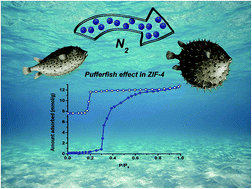New insights into the breathing phenomenon in ZIF-4†
Abstract
Structural changes in ZIFs upon adsorption remain a paradigm due to the sensitivity of the adsorption mechanism to the nature of the organic ligands and gas probe molecules. Synchrotron X-ray diffraction under operando conditions clearly demonstrates for the first time that ZIF-4 exhibits a structural reorientation from a narrow-pore (np) to a new expanded-pore (ep) structure upon N2 adsorption, while it does not do so for CO2 adsorption. The existence of an expanded-pore structure of ZIF-4 has also been predicted by molecular simulations. In simulations the expanded structure was stabilized by entropy at high temperatures and by strong adsorption of N2 at low temperatures. These results are in perfect agreement with manometric adsorption measurements for N2 at 77 K that show the threshold pressure for breathing at ∼30 kPa. Inelastic neutron scattering (INS) measurements show that CO2 is also able to promote structural changes but, in this specific case, only at cryogenic temperatures (5 K).



 Please wait while we load your content...
Please wait while we load your content...
